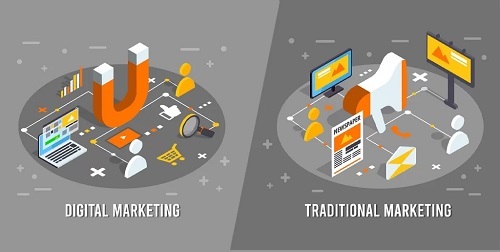Difference Between Digital marketing and traditional marketing
Digital marketing and traditional marketing are two distinct types of marketing efforts that are used to promote goods and services to different sales channels and to a larger, broader audience. Each type of marketing has its own unique strengths and weaknesses, and understanding their differences is important for any business.
The primary difference between digital and traditional marketing is the medium used for marketing. Digital marketing is conducted mainly through the use of the Internet and other digital technologies, including email, text messaging, search engine optimization, and social media. On the other hand, traditional marketing relies on print, radio, television, outdoor advertising, and other forms of non-digital media. One of the main advantages of digital marketing is that it enables businesses to measure the results of their campaigns in real time. It also allows for highly targeted campaigns because digital platforms can collect customer data and tailor campaigns to each customer’s particular preferences.
Another key difference between digital and traditional marketing is the cost. Digital marketing is generally less expensive than traditional marketing, since web-based campaigns do not require large investments in advertising space or airtime. Furthermore, digital campaigns can be scaleable, allowing businesses to expand their reach without increasing their marketing budget. On the contrary, traditional marketing often requires large investments in printing and advertising materials, and it is not as easy to modify campaigns in response to customer feedback.
The pace of customer engagement is also much faster in digital marketing than in traditional marketing. Consumers are more likely to interact with brands in real time when using digital media, giving businesses an opportunity to respond to customer inquiries and complaints faster. Digital marketing also enables businesses to track their campaigns in real time and quickly adjust or tweak their campaigns based on customer responses or feedback. On the other hand, traditional marketing lacks these tools and, therefore, is slower in responding to customer needs.
Finally, digital marketing may also be more effective in reaching a wider target audience. Consumers now use digital media more than traditional media and often spend more time online than they do watching television. As such, digital campaigns can be more effective at reaching customers who are more likely to be interested in a business’ products or services. It is also easier to target certain demographics or geographic regions with digital campaigns, which is not always possible in traditional marketing.
In conclusion, digital marketing and traditional marketing have their respective advantages and disadvantages. However, each type of marketing has its place in the modern business landscape, and it is important for businesses to understand the differences between the two in order to make the most effective use of each type of marketing.
- Smart Home Cameras Boost Women’s Confidence: Godrej Survey
- Baskin Robbins India Expands to Tap Quick Commerce, Snacking Boom
- Honorary Doctorate Conferred on Maruti Pawar, A Salute to a Visionary Leader in Steel and Innovation
- From Vision to Impact: Dr. Amit Bagwe Shapes Maharashtra’s Entrepreneurial Story
- Coins and Bars Are a Better Investment Than Gold Jewelry


